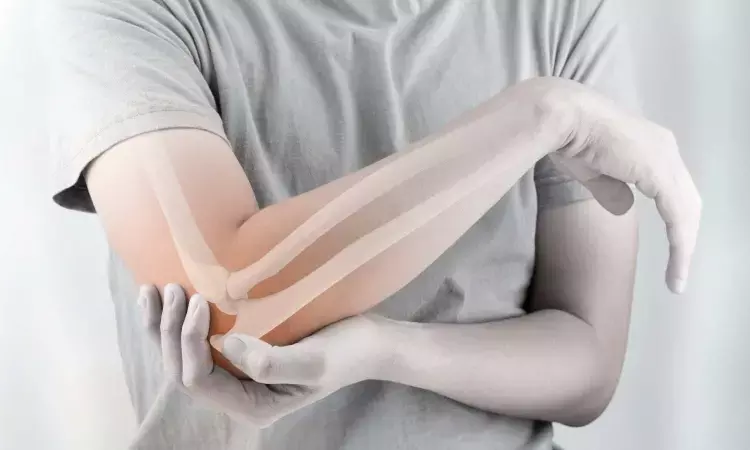- Home
- Medical news & Guidelines
- Anesthesiology
- Cardiology and CTVS
- Critical Care
- Dentistry
- Dermatology
- Diabetes and Endocrinology
- ENT
- Gastroenterology
- Medicine
- Nephrology
- Neurology
- Obstretics-Gynaecology
- Oncology
- Ophthalmology
- Orthopaedics
- Pediatrics-Neonatology
- Psychiatry
- Pulmonology
- Radiology
- Surgery
- Urology
- Laboratory Medicine
- Diet
- Nursing
- Paramedical
- Physiotherapy
- Health news
- Fact Check
- Bone Health Fact Check
- Brain Health Fact Check
- Cancer Related Fact Check
- Child Care Fact Check
- Dental and oral health fact check
- Diabetes and metabolic health fact check
- Diet and Nutrition Fact Check
- Eye and ENT Care Fact Check
- Fitness fact check
- Gut health fact check
- Heart health fact check
- Kidney health fact check
- Medical education fact check
- Men's health fact check
- Respiratory fact check
- Skin and hair care fact check
- Vaccine and Immunization fact check
- Women's health fact check
- AYUSH
- State News
- Andaman and Nicobar Islands
- Andhra Pradesh
- Arunachal Pradesh
- Assam
- Bihar
- Chandigarh
- Chattisgarh
- Dadra and Nagar Haveli
- Daman and Diu
- Delhi
- Goa
- Gujarat
- Haryana
- Himachal Pradesh
- Jammu & Kashmir
- Jharkhand
- Karnataka
- Kerala
- Ladakh
- Lakshadweep
- Madhya Pradesh
- Maharashtra
- Manipur
- Meghalaya
- Mizoram
- Nagaland
- Odisha
- Puducherry
- Punjab
- Rajasthan
- Sikkim
- Tamil Nadu
- Telangana
- Tripura
- Uttar Pradesh
- Uttrakhand
- West Bengal
- Medical Education
- Industry
Casting Alone Proven as Effective as Surgery for Displaced Pediatric Elbow Fractures: Study

In a new study published in JAMA casting has been found by researchers to be as effective as surgery in the treatment of displaced medial humeral epicondyle fractures in children. Displaced medial humeral epicondyle fractures are a frequent childhood injury. Long arm casting is traditionally used in the nonoperative treatment of these fractures. The study was conducted by Petra G. and colleagues.
The goal of this study was to compare the efficacy of surgical intervention through open reduction and internal fixation with casting in isolation for displaced medial humeral epicondyle fractures in children. The study, performed over four university hospitals in Finland between August 30, 2019, and August 22, 2023, incorporated a 12-month follow-up period to assess long-term functional outcome.
This noninferiority randomized clinical trial included 72 patients aged 7 to 16 years with displaced medial humeral epicondyle fractures (greater than 2 mm of displacement). Participants were randomly assigned to two groups:
• Surgery Group: Had open reduction and internal fixation, followed by a long arm cast for 4 weeks.
• Cast Group: Had a long arm cast without surgical reduction for 4 weeks.
The main outcome was assessed by the Quick Disabilities of the Arm, Shoulder, and Hand (QDASH) score at 12 months on a scale of 0 (no disability) to 100 (severe disability). The noninferiority margin was established at 6.8 points. The trial was carried out with an intention-to-treat analysis so that all the participants were analyzed according to their initially allocated treatment group.
Key Findings
Functional Outcomes
• Mean QDASH score at 12 months was 1.73 (95% CI, 0.65-2.81) for the cast group and 2.71 (95% CI, 0.52-4.90) for the surgery group, showing noninferiority of casting.
• The difference in mean QDASH scores between groups was −0.98 points (95% CI, −2.95 to 0.98), which was below the prespecified noninferiority margin of 6.8 points.-
Cosmetic Outcomes:
• The cast group had improved cosmetic results, with a statistically significant between-group difference of −8.9 points (95% CI, −16.6 to −1.2 points; P < .001) for the cosmetic visual analog scale.
Nonunion Rates:
• Nonunion was present in 1 of 37 patients (2.7%) in the surgical group, versus 24 of 35 patients (68.6%) in the cast group.
• In spite of the very high rate of nonunion in the cast group, this did not convert into poorer functional results at 12 months.
Demographic Data:
• 72 patients were included in the study, of whom 43 (59.7%) were female.
• The mean age of participants was 12.1 years (± 2.1 years), with an age range from 7.9 to 15.9 years.
Safety and Crossovers:
• No patients in the cast group had to crossover to surgery during the study.
Casting was determined to be noninferior to surgical intervention using internal fixation of displaced medial humeral epicondyle fracture in children in terms of outcomes at 12 months. Additional studies perhaps may be necessary to evaluate outcome beyond 12 months, yet, nonoperative treatment is safe and effective treatment for this particular pediatric fracture category.
Reference:
Grahn P, Helenius I, Hämäläinen T, et al. Casting vs Surgical Treatment of Children With Medial Epicondyle Fractures: A Randomized Clinical Trial. JAMA Netw Open. 2025;8(5):e258479. doi:10.1001/jamanetworkopen.2025.8479
Dr Riya Dave has completed dentistry from Gujarat University in 2022. She is a dentist and accomplished medical and scientific writer known for her commitment to bridging the gap between clinical expertise and accessible healthcare information. She has been actively involved in writing blogs related to health and wellness.
Dr Kamal Kant Kohli-MBBS, DTCD- a chest specialist with more than 30 years of practice and a flair for writing clinical articles, Dr Kamal Kant Kohli joined Medical Dialogues as a Chief Editor of Medical News. Besides writing articles, as an editor, he proofreads and verifies all the medical content published on Medical Dialogues including those coming from journals, studies,medical conferences,guidelines etc. Email: drkohli@medicaldialogues.in. Contact no. 011-43720751


